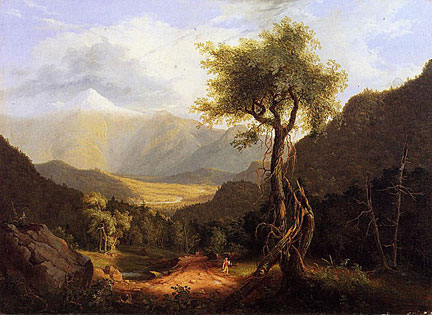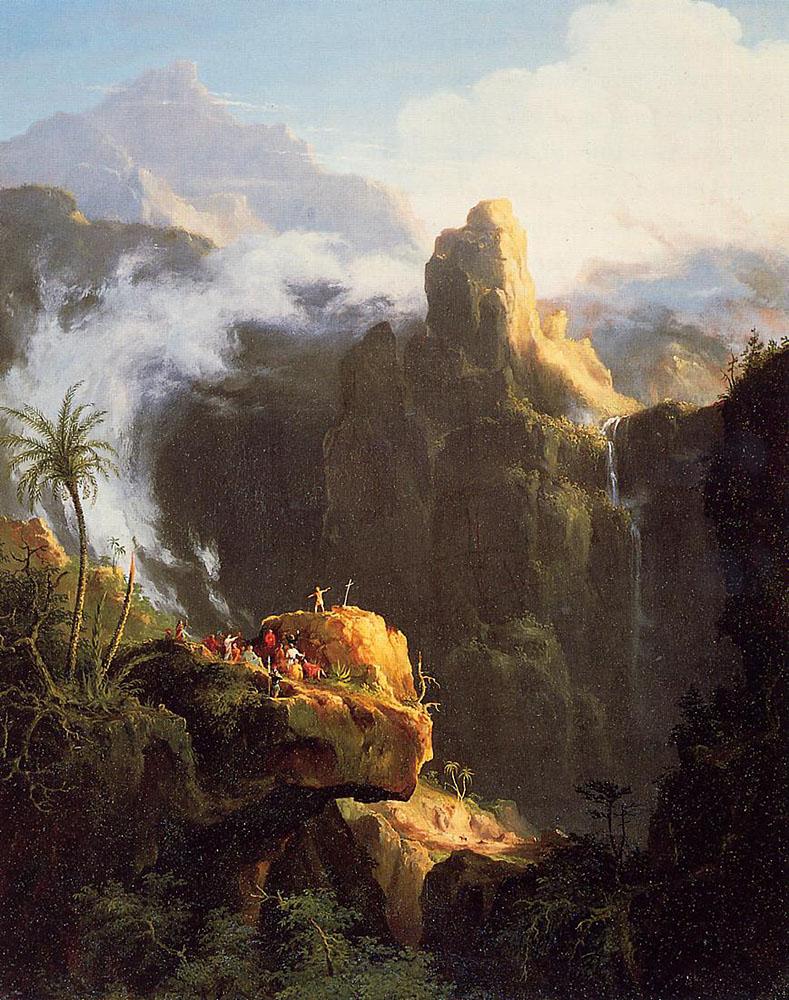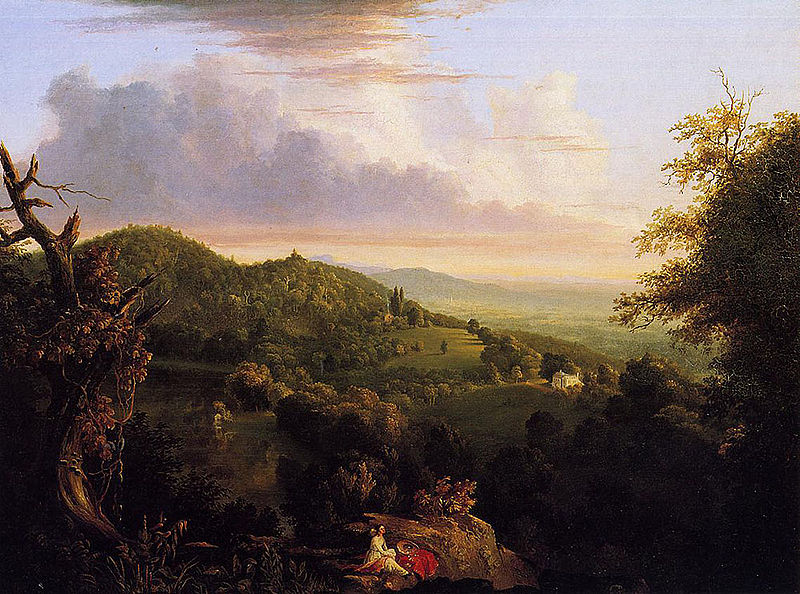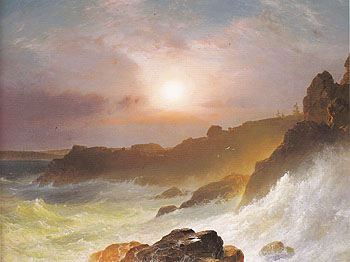The Iris & B. Gerald Cantor Center for Visual Arts at Stanford University showcased an exhibition of masterpieces from one of the world's foremost collections of Hudson River School paintings from October 8, 2003 to January 18, 2004. This selection of 55 paintings includes 10 by Thomas Cole, 11 by Frederic Church, and five by Albert Bierstadt. The exhibition Hudson River School: Masterworks from the Wadsworth Atheneum Museum of Art continues through at Stanford, then travels to six other museums across the U.S., including:
Carnegie Museum of Art, Pittsburgh - Feb-May 2004
Tacoma Art Museum - October 2, 2004 - January 16, 2005
Frist Center for the Visual Arts, Nashville (September 23, 2005 - January 8, 2006)
The exhibition was organized by the Wadsworth Atheneum Museum of Art, Hartford, Connecticut, from its permanent collection.
The core of this Hudson River School collection was formed by two major patrons of American artists who lived in Hartford, Connecticut: Daniel Wadsworth (1771–1848), a devoted traveler, amateur artist and architect, and founder of the Wadsworth Atheneum, and Elizabeth Hart Jarvis Colt (1826–1905), widow of arms manufacturer Samuel Colt. Many works were commissioned for their personal enjoyment. Due to their patronage, the Wadsworth Atheneum's collection reflects the evolving aesthetic sensibilities of two generations of Hudson River School painters. In turn, the works reveal the emerging sense of an American national identity, which was also evident in the writings of 19th-century authors such as Ralph Waldo Emerson and James Fenimore Cooper.
![]()
Thomas Cole, “View in the White Mountains” 1827
The origins of the Hudson River School traditionally are attributed to Thomas Cole, who was born in England and raised in Ohio before arriving in New York City in 1825. Cole was a more cerebral painter than his predecessors, and he used his art as a moral as well as aesthetic platform. Breaking from the traditional European taste for manicured pastoral views, Cole depicted the virginal, primeval wilderness of the American northeast. It was a paradise already lost, however, for Native Americans had been chased from their lands, white settlements had been long established, and tourism was beginning to boom.
Wadsworth introduced 17-year-old Hartford native and aspiring artist Frederic Church to Thomas Cole, who made Church his sole apprentice. Wadsworth then purchased Church's first mature painting, Hooker and Company Journeying Through the Wilderness from Plymouth to Hartford in 1636 (created in1846), for $130, acquiring it for the newly founded Wadsworth Atheneum. Church was then 20 years of age. Later, during the Civil War, Church advised Elizabeth Hart Jarvis Colt in assembling an impressive private picture gallery for her mansion, Armsmear, in Hartford. He introduced her to Albert Bierstadt, William Bradford, John Kensett, Sanford Gifford, and others, from whom she commissioned paintings.
Related article and images
![]()
Figure 1, Thomas Cole, Kaaterskill Falls, 1826. Oil on canvas; 251⁄4 x 365⁄16 in.
Bequest of Daniel Wadsworth, 1848.14
![]()
Figure 2, Thomas Cole, Landscape Composition, St. John in the
Wilderness, 1827. Oil on canvas; 36 x 29 in. Bequest of Daniel
Wadsworth, 1848.16
![]()
Figure 3, Thomas Cole, Scene from “The Last of the Mohicans”:
Cora Kneeling at the Feet of Tamenund, 1827. Oil on canvas,
253⁄8 x 35 in. The Wadsworth Atheneum Museum of Art
Bequest of Alfred Smith, 1868.3
![]()
Figure 4, Thomas Cole, View on Lake Winnipiseogee, 1828. Oil
on canvas; 193⁄4 x 261⁄8 in. Bequest of Daniel Wadsworth, 1848.13
![]()
Figure 5, Thomas Cole, View of Monte Video, the Seat of Daniel
Wadsworth, Esq., 1828. Oil on canvas; 193⁄4 x 261⁄16 in. Bequest of
Daniel Wadsworth, 1848.14
![]()
Figure 6, Thomas Cole, Mount Etna from Taormina, 1843. Oil on canvas, 78 5⁄8 x 120 in.
The Wadsworth Atheneum Museum of Art. Museum Purchase, 1844.6
![]()
Figure 7, Frederic E. Church, Hooker and Company Traveling
through the Wilderness from Plymouth to Hartford, in 1636,
1846. Oil on canvas, 401⁄4 x 60 in. The Wadsworth Atheneum
Museum of Art, Museum Purchase, 1850.9
![]()
Figure 8, Frederic E. Church, Grand Manan Island, Bay of Fundy,
1852. Oil on canvas, 2113⁄16 x 31 in. The Wadsworth Atheneum
Museum of Art. Gallery Purchase Fund, 1898.6
![]()
Figure 9, Frederic E. Church, Coast Scene, Mount Desert, 1863.
Oil on canvas; 361⁄8 x 48 in. Bequest of Clara Hinton Gould,
1948.178
![]()
Figure 10, Frederic E. Church, Vale of St. Thomas, Jamaica, 1867.
Oil on canvas, 485⁄16 x 84 in. The Wadsworth Atheneum Museum of Art.
Bequest of Elizabeth Hart Jarvis Colt, 1905.21
![]()
Figure 11, Asher B. Durand, View Toward the Hudson River
Valley, 1851. Oil on canvas, 331⁄8 x 481⁄8 in. The Wadsworth
Atheneum Museum of Art. The Ella Gallup Sumner and Mary
Catlin Sumner Collection Fund, 1948.119
![]()
Figure 12, Albert Bierstadt. In the Mountains, 1867. Oil on
canvas, 363⁄16 x 50 in. The Wadsworth Atheneum Museum of Art.
![]()
Figure 13, Albert Bierstadt, Toward the Setting Sun, 1862. Oil on
canvas; 73⁄4 x 14 in. Gift of Mr. J. Harold Williams, in memory of
Edith Russell Wooley, 1977.74
![]()
Figure 14, John F. Kensett, Coast Scene With Figures (Beverly
Shore), 1869. Oil on canvas, 36 x 60 3⁄8 in. The Wadsworth
Atheneum Museum of Art. The Ella Gallup Sumner and Mary
Catlin Sumner Collection Fund, 1942.345
by Kensett’s Coast Scene
Catalogue
![]()
Hudson River School - Masterworks from the Wadsworth Atheneum Museum of Art
180 p., 9 1/2 x 12
34 b/w + 67 color illus.
ISBN: 9780300101164
* Introduction by Elizabeth Mankin Kornhauser; Catalogue by Elizabeth Mankin Kornhauser and Amy Ellis, with Maureen Miesmer
This book features fifty-seven major Hudson River School paintings from the collection of the Wadsworth Atheneum Museum of Art, recognized as the most extensive and finest in the world.
Gorgeously and amply illustrated, the book includes paintings by all the major figures of the Hudson River School. Each work is beautifully reproduced in full color and is accompanied by a concise description of its significance and historical background. The book also includes artists’ biographies and a brief introduction to American nineteenth-century landscape painting and the Wadsworth Atheneum’s unique role in collecting Hudson River pictures.
About the Wadsworth Atheneum Museum of Art:
The quality and range of fine and decorative arts at the Wadsworth Atheneum place it among the dozen greatest art museums in the United States. Its world-renowned collections include Old Master paintings, modernist masterpieces, 19th-century French and Impressionist paintings, Meissen and Sevres porcelains, costumes and textiles, American furniture and decorative arts of the Pilgrim Century through the Gilded Age, and the vanguard of contemporary art.
The Wadsworth Atheneum is named for its founder, the arts patron and philanthropist Daniel Wadsworth (1771–1848), and after the Athenaeum in Rome (itself named for Athena, the Greek goddess of wisdom). Established in 1842, the Wadsworth Atheneum is America's oldest public art museum, preceding the founding of The Metropolitan Museum of Art in New York and the Museum of Fine Arts in Boston by three decades. It was the first American museum to acquire works by Michelangelo Merisi da Caravaggio, Frederic Church, Salvador DalÌ, Joan Miro, Alexander Calder, Piet Mondrian, Joseph Cornell, and Max Ernst.
Carnegie Museum of Art, Pittsburgh - Feb-May 2004
Tacoma Art Museum - October 2, 2004 - January 16, 2005
Frist Center for the Visual Arts, Nashville (September 23, 2005 - January 8, 2006)
The exhibition was organized by the Wadsworth Atheneum Museum of Art, Hartford, Connecticut, from its permanent collection.
The core of this Hudson River School collection was formed by two major patrons of American artists who lived in Hartford, Connecticut: Daniel Wadsworth (1771–1848), a devoted traveler, amateur artist and architect, and founder of the Wadsworth Atheneum, and Elizabeth Hart Jarvis Colt (1826–1905), widow of arms manufacturer Samuel Colt. Many works were commissioned for their personal enjoyment. Due to their patronage, the Wadsworth Atheneum's collection reflects the evolving aesthetic sensibilities of two generations of Hudson River School painters. In turn, the works reveal the emerging sense of an American national identity, which was also evident in the writings of 19th-century authors such as Ralph Waldo Emerson and James Fenimore Cooper.

Thomas Cole, “View in the White Mountains” 1827
The origins of the Hudson River School traditionally are attributed to Thomas Cole, who was born in England and raised in Ohio before arriving in New York City in 1825. Cole was a more cerebral painter than his predecessors, and he used his art as a moral as well as aesthetic platform. Breaking from the traditional European taste for manicured pastoral views, Cole depicted the virginal, primeval wilderness of the American northeast. It was a paradise already lost, however, for Native Americans had been chased from their lands, white settlements had been long established, and tourism was beginning to boom.
Wadsworth introduced 17-year-old Hartford native and aspiring artist Frederic Church to Thomas Cole, who made Church his sole apprentice. Wadsworth then purchased Church's first mature painting, Hooker and Company Journeying Through the Wilderness from Plymouth to Hartford in 1636 (created in1846), for $130, acquiring it for the newly founded Wadsworth Atheneum. Church was then 20 years of age. Later, during the Civil War, Church advised Elizabeth Hart Jarvis Colt in assembling an impressive private picture gallery for her mansion, Armsmear, in Hartford. He introduced her to Albert Bierstadt, William Bradford, John Kensett, Sanford Gifford, and others, from whom she commissioned paintings.
Related article and images

Figure 1, Thomas Cole, Kaaterskill Falls, 1826. Oil on canvas; 251⁄4 x 365⁄16 in.
Bequest of Daniel Wadsworth, 1848.14

Figure 2, Thomas Cole, Landscape Composition, St. John in the
Wilderness, 1827. Oil on canvas; 36 x 29 in. Bequest of Daniel
Wadsworth, 1848.16
Figure 3, Thomas Cole, Scene from “The Last of the Mohicans”:
Cora Kneeling at the Feet of Tamenund, 1827. Oil on canvas,
253⁄8 x 35 in. The Wadsworth Atheneum Museum of Art
Bequest of Alfred Smith, 1868.3
Figure 4, Thomas Cole, View on Lake Winnipiseogee, 1828. Oil
on canvas; 193⁄4 x 261⁄8 in. Bequest of Daniel Wadsworth, 1848.13

Figure 5, Thomas Cole, View of Monte Video, the Seat of Daniel
Wadsworth, Esq., 1828. Oil on canvas; 193⁄4 x 261⁄16 in. Bequest of
Daniel Wadsworth, 1848.14

Figure 6, Thomas Cole, Mount Etna from Taormina, 1843. Oil on canvas, 78 5⁄8 x 120 in.
The Wadsworth Atheneum Museum of Art. Museum Purchase, 1844.6

Figure 7, Frederic E. Church, Hooker and Company Traveling
through the Wilderness from Plymouth to Hartford, in 1636,
1846. Oil on canvas, 401⁄4 x 60 in. The Wadsworth Atheneum
Museum of Art, Museum Purchase, 1850.9

Figure 8, Frederic E. Church, Grand Manan Island, Bay of Fundy,
1852. Oil on canvas, 2113⁄16 x 31 in. The Wadsworth Atheneum
Museum of Art. Gallery Purchase Fund, 1898.6

Figure 9, Frederic E. Church, Coast Scene, Mount Desert, 1863.
Oil on canvas; 361⁄8 x 48 in. Bequest of Clara Hinton Gould,
1948.178

Figure 10, Frederic E. Church, Vale of St. Thomas, Jamaica, 1867.
Oil on canvas, 485⁄16 x 84 in. The Wadsworth Atheneum Museum of Art.
Bequest of Elizabeth Hart Jarvis Colt, 1905.21

Figure 11, Asher B. Durand, View Toward the Hudson River
Valley, 1851. Oil on canvas, 331⁄8 x 481⁄8 in. The Wadsworth
Atheneum Museum of Art. The Ella Gallup Sumner and Mary
Catlin Sumner Collection Fund, 1948.119

Figure 12, Albert Bierstadt. In the Mountains, 1867. Oil on
canvas, 363⁄16 x 50 in. The Wadsworth Atheneum Museum of Art.

Figure 13, Albert Bierstadt, Toward the Setting Sun, 1862. Oil on
canvas; 73⁄4 x 14 in. Gift of Mr. J. Harold Williams, in memory of
Edith Russell Wooley, 1977.74

Figure 14, John F. Kensett, Coast Scene With Figures (Beverly
Shore), 1869. Oil on canvas, 36 x 60 3⁄8 in. The Wadsworth
Atheneum Museum of Art. The Ella Gallup Sumner and Mary
Catlin Sumner Collection Fund, 1942.345
by Kensett’s Coast Scene
Catalogue

Hudson River School - Masterworks from the Wadsworth Atheneum Museum of Art
180 p., 9 1/2 x 12
34 b/w + 67 color illus.
ISBN: 9780300101164
* Introduction by Elizabeth Mankin Kornhauser; Catalogue by Elizabeth Mankin Kornhauser and Amy Ellis, with Maureen Miesmer
This book features fifty-seven major Hudson River School paintings from the collection of the Wadsworth Atheneum Museum of Art, recognized as the most extensive and finest in the world.
Gorgeously and amply illustrated, the book includes paintings by all the major figures of the Hudson River School. Each work is beautifully reproduced in full color and is accompanied by a concise description of its significance and historical background. The book also includes artists’ biographies and a brief introduction to American nineteenth-century landscape painting and the Wadsworth Atheneum’s unique role in collecting Hudson River pictures.
About the Wadsworth Atheneum Museum of Art:
The quality and range of fine and decorative arts at the Wadsworth Atheneum place it among the dozen greatest art museums in the United States. Its world-renowned collections include Old Master paintings, modernist masterpieces, 19th-century French and Impressionist paintings, Meissen and Sevres porcelains, costumes and textiles, American furniture and decorative arts of the Pilgrim Century through the Gilded Age, and the vanguard of contemporary art.
The Wadsworth Atheneum is named for its founder, the arts patron and philanthropist Daniel Wadsworth (1771–1848), and after the Athenaeum in Rome (itself named for Athena, the Greek goddess of wisdom). Established in 1842, the Wadsworth Atheneum is America's oldest public art museum, preceding the founding of The Metropolitan Museum of Art in New York and the Museum of Fine Arts in Boston by three decades. It was the first American museum to acquire works by Michelangelo Merisi da Caravaggio, Frederic Church, Salvador DalÌ, Joan Miro, Alexander Calder, Piet Mondrian, Joseph Cornell, and Max Ernst.